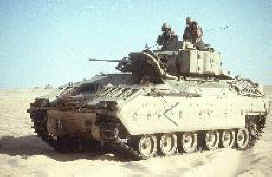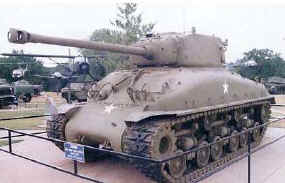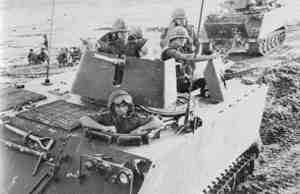The M2 Bradley Infantry Fighting vehicle is a three million dollar version of the World War II Sherman tank, with room in the back for six guys. It weighs 30 tons, so its too heavy to be picked up by any helicopter and too large to be carried by a C-130, and is not truly amphibious. It's expensive to operate, expensive to maintain, and only carries six infantrymen. Worst of all, its a huge vehicle with little armor and packed with explosive TOW missiles.


The M2 Bradley is no better armored than a WW II Sherman tank
The idea of mechanized vehicles is to carry infantrymen behind tanks until they are needed. However, the US Army cannot field a vehicle to safely transport a dozen grunts, it must add every known gadget to field a golden "fighting vehicle". The M1A1 tank is a fighting vehicle, the Bradley is an exploding coffin. The Bradley is almost 10 feet tall, but can only carry six grunts who are trapped inside with explosive TOW missiles. During live fire tests of the Bradley, a hit usually ignited a stored TOW causing massive explosions.
The Bradley looks good in peacetime exercises, including the invasion of Iraq, but it will not do well with an enemy who shoots back. The Army has tried to counter criticism by putting extra armor on the upgraded Bradley's, but its still a huge target with little armor slope. Upgraded Bradleys are weighted down with external armor plates, but even these can be penetrated with light infantry anti-armor weapons.
M1A1 tanks have plenty of firepower, they don't
need TOW support from Bradleys, nor 25mm chain gun support. Tanks need
grunts to flush out enemy forces hidden in difficult terrain, like cities.
A good infantry carrier would be an M1 tank chassis. The Army has
thousands of surplus M1 tanks, it should pull off their turret and gut them to make
room for a squad of grunts. The top should be covered with an armored canopy
"tank roof" to provide overhead blast protection and storage racks.
Without the heavy turret, the M1 troop carrier would not need a fuel devouring
gas turbine engine, the Bradley engines should do fine.
An M1 troop carrier would provide excellent protection from
anti-armor weapons and land mines. The open space allows a 360 degree view
for grunts to access the situation, employ their personal weapons, or dismount
in any direction by sliding over the sides.
tanks, it should pull off their turret and gut them to make
room for a squad of grunts. The top should be covered with an armored canopy
"tank roof" to provide overhead blast protection and storage racks.
Without the heavy turret, the M1 troop carrier would not need a fuel devouring
gas turbine engine, the Bradley engines should do fine.
An M1 troop carrier would provide excellent protection from
anti-armor weapons and land mines. The open space allows a 360 degree view
for grunts to access the situation, employ their personal weapons, or dismount
in any direction by sliding over the sides. 
Ideally, a 50. cal machine gun or 40mm automatic grenade launcher would be mounted forward and a 7.62mm machine gun on each side (all with gun shields); similar to the way M113 ACAVs (pictured right) were configured in Vietnam. The Army needs to stop wasting billions of dollars to upgrade the Bradley death traps and start fielding safe M1 troop carriers with three machine guns to kill enemy infantry.
Carlton Meyer editorG2mil@Gmail.com
Letters
How we got the M2 Bradley
You have to recall the context of the times when the Bradley was designed. During the Cold war, we were looking at an inverse force ratio of 1-3 at best and possibly a lot worse in armored/mechanized warfare against Soviet design armored units. In such a situation how do you massively proliferate heavy tank killing weapons without eliminating the infantry entirely? Second problem. Tankers don't like to hear this, but the M1 is so heavily optimized for anti-tank combat that it's useless as an anti-personnel weapon, especially if artillery or mortar fragments are also flying. The commander has to button up then, the coax machinegun is not so flexible and anti-personnel engagement takes the crew's attention away from enemy tanks and heavy weapons.
Prior to the Bradley the mechanized M-113 infantry battalions had 12-18 TOWs depending on the size of the anti-tank platoon. After the Bradley, every squad had a TOW and we still had the 12-18 M113 hull based Improved TOW Vehicles with their excellent hull down shooting capability. The number of heavy TOW tank killers in an infantry battalion zoomed from 12-18 up to around 60+. The 12-18 TOW M-113 battalion design had zero chance against a Soviet tank regiment assault with 100 T-72s and 50 BMPs. The 60+ TOW Bradley design had a very good chance with all those missiles plus the 25mm chain gun which was lethal against anything short of a tank.
Is the comparison of a Bradley IFV and a Sherman tank fair? It seems to be open to the apples and oranges criticism. Isn't the fair comparison the WWII half-track with its .50 caliber machinegun (the APC of that era) and the M2/M3 Bradley? The Bradley doesn't look so bad in that comparison. One objection to the Bradley battalion (made before it was bought in 1979), and one reason that Shinseki wants 'medium brigades' now, is that a Bradley battalion dismounts many fewer infantry compared to the M113 battalion. At best the squad's ground pounder portion is -6- troops, assuming 100% manning. The Bradley needs a crew of 3 compared the M-113's 2 man crew. The maintenance and logistics overhead went up also with the proliferation of heavy weapons.
We recognized that these units had almost no urban combat capability, at least in close combat. They're not something we'd ever send to jungles of course except in limited numbers. A tough choice, eh? The bigger risk in 1978 seemed to be the Soviet tank regiment breaking through so stopping that became Job #1. The one known factor was that M-113s could not carry both TOWs and a squad or even a fire team. You can only put so many marbles in a given size can no matter how artistically you pack them in.
The next problem was the emerging mobility gap between the M1 and the M113. The M1 is much more mobile than the M-60,. The M-113 was contemporary to the M-60 and couldn't keep up with M1s. M2-M3 does keep up with M1s. Is the Bradley the best possible infantry carrier for a full squad? Nope. That was the inherent trade-off given available 1970s technology for radically increasing the tank killing power of 9 man infantry units. Was the conception of increasing the tank killing power correct? Absolutely. A somewhat more compact design (but still larger than the M-113) was possible. Designs incorporating a TOW and a 20mm but no big turret were looked at and might have been better.
That turret is the deceptive part. The Bradley is not a tank, despite having a turret and irrespective of what Barry McCaffrey was saying in the late 1980s. Think of it as a super-gun shield better than the .50 calibers M-113s had in Vietnam. The next consideration that caused the turret to be picked was chemical warfare and the desire for a fully enclosed design to protect the crew. The last consideration is that the TOW launcher has to be pivotable however you achieve that. It's inherent to the design of the TOW guidance system. Ground mounted TOWs pivot on a tripod. Jeep and HMMWV TOWs pivot on a pintle. Cobra mounted TOWs pivot around the aircraft rotor axle. The ITV is really an M-113 hull carrying a pop-up turret.
The real choice was therefore between a tiny
turret for the TOW only or a larger turret incorporating the TOW and guns. If
one is dead-set against turrets in infantry vehicles but still wants a heavy
anti-tank missile then a completely new missile was necessary. The TOW was fully
developed and combat proven at An Loc in 1972 and a year later in the
Sinai. This vehicle was optimized to fight with the M1 against Soviet
armored forces using chemical warfare in central Europe and the
Mid-East. To say that it's not ideal for Bosnian peacekeeping or Just
Cause in Panama is true and irrelevant. I still think a better and lighter
design with better amphibious capability was possible. But we certainly should
not spend the money to build that better vehicle now.
Mark Gallmeier enigma@gate.net
M1 Troop Carrier
The M1 APCs you mention are interesting -such vehicles were created in WW2 by commonwealth forces are were termed "kangeroos"-because of their better armor, some of these were mounted with the flamethrowing apparatus usually used on universal carriers. The Russians have already created APCs from tank chassis (as have the Israelis) and these have been termed TPCs.
Phil West phil.west@angelfire.com